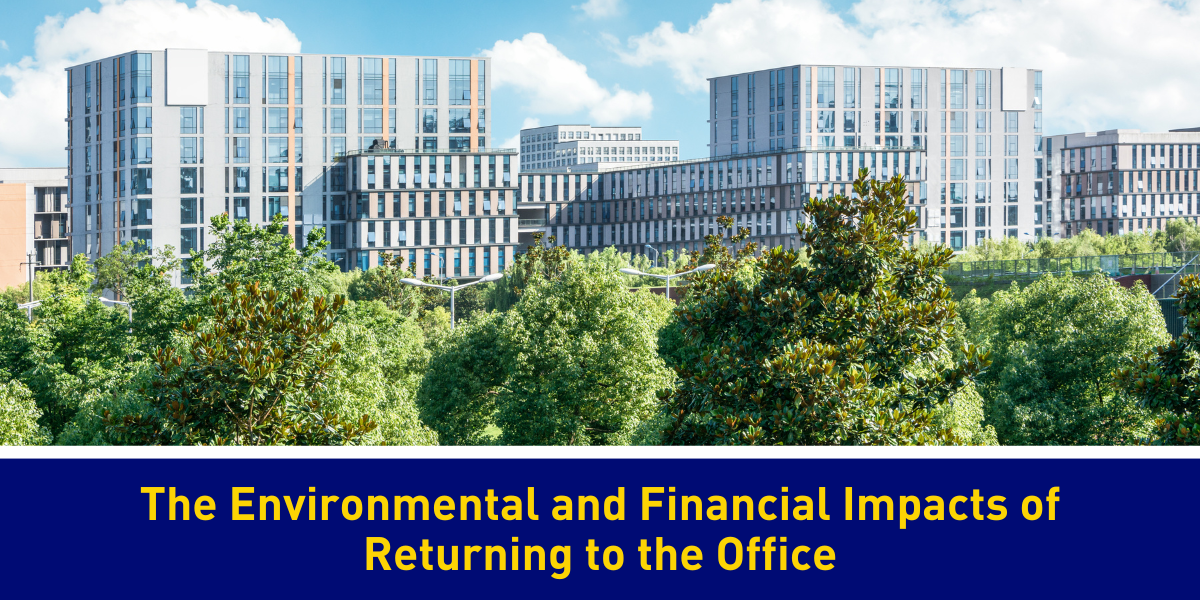As the world emerges from the throes of the COVID-19 pandemic, many companies are implementing return-to-office (RTO) policies across the United States. For many workers, the flexibility of remote work during the pandemic was a welcome change, allowing them to avoid the daily grind of commuting and work from the comfort of their homes. However, as businesses push to bring employees back to physical office spaces, the question arises: What are the environmental and financial consequences of this shift? What do RTO policies mean for climate change, the economy, and workers themselves?
Let’s examine the environmental impact of working in an office versus working remotely, the costs to both companies and workers, and what actions can be taken to reduce the overall environmental footprint as we navigate the return to the office.
Environmental Impact: Office Work vs. Remote Work
The environmental footprint of working in an office setting is significantly different from that of working from home. One of the most noticeable aspects is the increase in energy consumption. Office buildings require constant energy to run lighting, heating, cooling, and electrical equipment. In fact, according to the U.S. Energy Information Administration, commercial buildings account for nearly 20% of total energy consumption in the United States. This energy is often derived from nonrenewable sources, contributing to higher carbon emissions, especially in buildings that aren’t energy-efficient or use fossil fuels for heating.
On the flip side, when employees work remotely, this energy usage is transferred to their homes, but it’s often on a smaller scale. The energy consumption for lighting, heating, and cooling is generally less in a household than in a large commercial building. Additionally, many workers may have more flexibility to optimize their energy usage, such as using natural light, adjusting heating settings, or turning off equipment when not in use.
The environmental impact is also heavily influenced by commuting. When employees return to the office, they are typically required to drive or take public transportation, both of which have their environmental consequences. According to the U.S. Environmental Protection Agency, the transportation sector accounts for nearly 30% of greenhouse gas emissions in the U.S., with personal vehicles being one of the largest contributors. In contrast, remote workers eliminate the need for commuting altogether, significantly reducing their carbon footprint.
Cost to Companies
While many companies are pushing to return to the office, it’s worth considering the financial impact of this decision. Office spaces are expensive to maintain, with costs associated with rent, utilities, office supplies, cleaning, and more. During the pandemic, many businesses embraced remote work, reducing or eliminating their need for large office spaces. For example, tech companies like Twitter and Facebook made headlines by offering permanent remote work options for employees. This allowed them to reduce their office space, cutting down on rental costs and utility bills.
As companies begin to require employees to return to the office, they will face a resurgence in these expenses. The need for office space, heating, air conditioning, and office infrastructure will undoubtedly lead to higher operational costs. For businesses that have embraced hybrid work models, the cost of redesigning office spaces to accommodate flexible schedules and social distancing practices could add up as well.
In a world of rising energy costs and a growing emphasis on sustainability, some companies are encouraged to invest in energy-efficient buildings and renewable energy sources. While these changes can be costly upfront, they are ultimately a long-term investment that can help mitigate some of the environmental costs associated with traditional office work.
Cost to Workers
For employees, the return to the office can bring additional financial burdens. First and foremost is the cost of commuting. Gas prices and public transportation fares can add up quickly, especially for workers who live far from their office buildings. According to a 2022 study by the U.S. Census Bureau, Americans spend an average of 26 minutes commuting each way to work, and this doesn’t account for the wear and tear on their vehicles. For workers who previously enjoyed the cost-saving benefits of remote work, these expenses can feel like a financial setback.
Additionally, the need for work attire, lunches, and other office-related costs can add up. Remote workers can enjoy the comfort of dressing casually and cooking meals at home, but when required to return to the office, they may need to invest in new clothes, transportation, and dining options.
While there are financial costs for employees when returning to the office, it’s important to note that some workers may benefit from the social and professional advantages of being in a collaborative, in-person work environment. The ability to network, attend meetings, and engage with colleagues face-to-face can enhance career growth and productivity.
The Impact of Increased Commuting on Climate Change
One of the most critical environmental concerns surrounding the return to the office is the impact of increased commuting. As employees drive to and from work, their personal vehicles emit greenhouse gases, contributing to global warming. Even though public transportation options may be available, they are often less efficient or not an option for workers who live in suburban or rural areas.
The increase in daily commutes also leads to traffic congestion, which results in more idling and longer travel times, further increasing emissions. According to a report from the Center for Climate and Energy Solutions, the average commuter vehicle emits around 4,900 pounds of CO2 annually. Given the sheer number of workers returning to their offices, this can lead to a substantial increase in pollution levels.
If businesses and employees return to pre-pandemic commuting patterns, we can expect a sharp rise in carbon emissions from the transportation sector, which will only exacerbate climate change.
How Can We Minimize the Environmental Impact?
Although the return to the office may increase carbon emissions and costs, there are steps we can take to reduce the environmental impact. For both businesses and workers, small changes can make a significant difference.
- Encourage Hybrid or Flexible Work Models
One of the most effective ways to reduce the environmental impact of office work is to maintain hybrid or flexible work models. By allowing employees to work from home a few days a week, businesses can reduce the need for daily commuting and lessen energy consumption in office buildings. This approach balances the benefits of in-person collaboration with the environmental benefits of remote work.
- Promote Sustainable Commuting
For employees who must commute, companies can encourage the use of public transportation, carpooling, or biking to work. Some companies even offer incentives like transportation stipends or bike storage to make sustainable commuting more attractive. Additionally, businesses could support the transition to electric vehicles by installing EV charging stations at office locations.
- Invest in Energy-Efficient Office Spaces
To further reduce the environmental impact, businesses can invest in energy-efficient office buildings. This could include retrofitting old buildings with energy-saving technologies, such as LED lighting, energy-efficient HVAC systems, and solar panels. Companies can also opt to purchase renewable energy or carbon credits to offset their carbon footprint.
- Promote Remote Work Infrastructure
For workers who prefer working from home, companies can offer support for setting up home offices with energy-efficient appliances and equipment. Promoting the use of renewable energy sources at home can also have a positive impact.
- Reevaluate the Need for Physical Office Space
Rather than committing to a full return to office work, businesses could reassess their office space needs. Instead of filling large office buildings with employees every day, companies could consider smaller, shared spaces that accommodate employees on a flexible basis.
Explore Sustainable Options
As businesses across the U.S. continue to navigate the return to office work, it’s essential to consider both the environmental and financial implications of this decision. The increased energy usage in office buildings, the rising cost of commuting, and the environmental consequences of personal vehicle emissions are all factors that contribute to the environmental footprint of office work.
However, by implementing hybrid work models, promoting sustainable commuting options, and investing in energy-efficient office spaces, both companies and employees can mitigate some of the negative effects of returning to the office. These changes will not only help combat climate change but also create a more sustainable and cost-effective future for both businesses and workers alike. The key is to find a balance that maximizes productivity and sustainability while minimizing our environmental impact.
What is your current office situation? Are all employees back in the office? Have you implemented a hybrid work model? We would like to hear from you. Let’s take a look at the various factors that are increasing your costs and identify potential solutions together.






